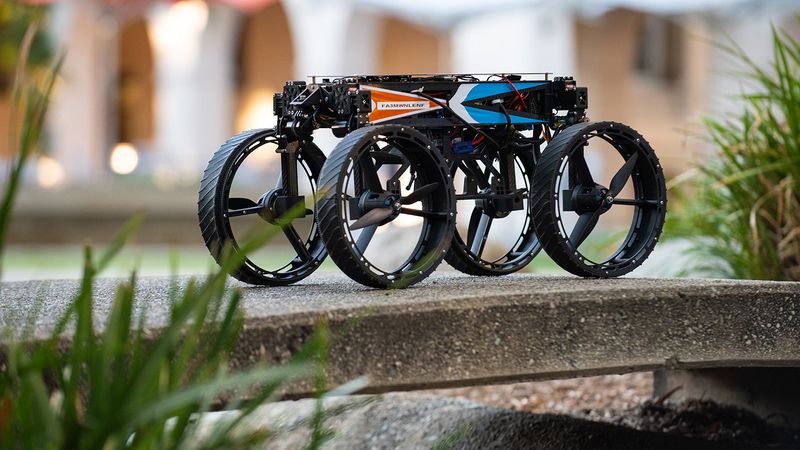New Bioinspired Robot Flies, Rolls, Walks, and More
A newly created real-life Transformer is capable of reconfiguring its body to achieve eight distinct types of motion and can autonomously assess the environment it faces to choose the most effective combination of motions to maneuver.

This article was discussed in our Next Byte podcast.
The full article will continue below.
The new robot, dubbed M4 (for Multi-Modal Mobility Morphobot) can roll on four wheels, turn its wheels into rotors and fly, stand on two wheels like a meerkat to peer over obstacles, "walk" by using its wheels like feet, use two rotors to help it roll up steep slopes on two wheels, tumble, and more.
A robot with such a broad set of capabilities would have applications ranging from the transport of injured people to a hospital to the exploration of other planets, says Mory Gharib (PhD '83), the Hans W. Liepmann Professor of Aeronautics and Bioinspired Engineering and director of Caltech's Center for Autonomous Systems and Technologies (CAST), where the robot was developed.
M4 is the brainchild of Gharib and Alireza Ramezani, assistant professor of electrical and computer engineering at Northeastern University. The team supporting M4's technical aspects consisted of Eric Sihite, a postdoctoral scholar research associate in aerospace at Caltech; Reza Nemovi, a design engineer at CAST; and Arash Kalantari from JPL, which Caltech manages for NASA. A paper announcing the new robot was published in Nature Communications on June 27.
"Our aim was to push the boundaries of robot locomotion by designing a system that showcases extraordinary mobility capabilities with a wide range of distinct locomotion modes. The M4 project successfully achieved these objectives," says Ramezani, corresponding author of the Nature Communications paper.
The robot's flexibility of motion, coupled with artificial intelligence, allows it to choose what form of locomotion will be most effective based on the terrain ahead of it. Picture the M4 exploring an unfamiliar environment: it might start by rolling along on four wheels, which is its most energy-efficient mode. Upon reaching an obstacle like a boulder, it could stand on two wheels to peer over it for a clearer picture of the ground ahead. Then, if it saw a ravine or another feature that a wheeled robot could not traverse, it could reconfigure its wheels into rotors, fly over the ravine to the other side, and resume rolling along.
"When encountering unknown environments, only robots that have the ability to repurpose their multi-modal components aided by artificial intelligence can succeed," says Gharib, co-author of the Nature Communications paper.
One of the key features of M4 is its ability to repurpose its appendages to wheels, legs, or thrusters. When M4 needs to stand up on two wheels, two of its four wheels fold up and their inset propellors spin upwards, providing balance for the robot. When M4 needs to fly, all four wheels fold up, and the propellors lift the robot off the ground.

Joints on the wheel assemblies allow M4 to execute a walking motion. In M4's current iteration, the walking motion is mostly proof of concept. However, with anticipated advances, future M4 generations could possess the ability to effectively walk across broken terrain that a wheeled robot would struggle with.

The design of M4 was heavily influenced by nature: Gharib and his colleagues were inspired by how chukar birds (a type of partridge) use the flapping of their wings to give them leverage while running up steep inclines, for example, and how sea lions use their flippers for different types of locomotion on sea and land. Although such examples of appendage repurposing from the animal kingdom have been previously reported by biologists, the concepts they illustrate are just now being explored in the engineering domain.
M4 has been equipped with autonomous capabilities and can make decisions for itself about how best to navigate through a complex environment. The robot has also been tested outdoors and has navigated the terrain of Caltech's campus.
The Nature Communications paper is titled "Multi-Modal Mobility Morphobot (M4), A Platform to Inspect Appendage Repurposing for Locomotion Plasticity Enhancement." This research was funded by JPL and the National Science Foundation.